This post contains affiliate links. As an Amazon Associate I earn from qualifying purchases.
It feels like we’re living in the golden age of innovative baby and kid gear. Brands are realizing that parents are willing to pony up for game-changing products that make life easier, and parents with ideas and know-how are getting involved in design as well.
The parents at the mifold company started with their groundbreaking folding backless booster seat a few years ago, and they’re back at it again with a new innovation: the mifold hifold fit-and-fold highback booster car seat. In this in-depth hifold review, you’ll find out what it is, who it’s for and my honest impressions of the hifold booster seat after testing it out.
What is the hifold by mifold?
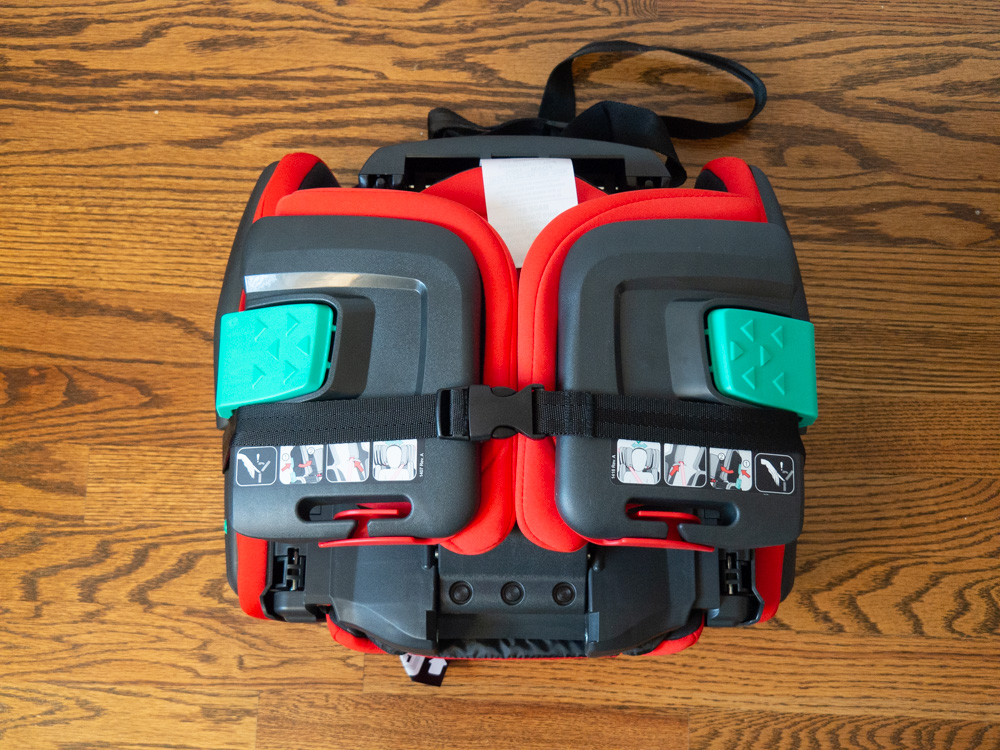
Hifold the fit-and-fold booster seat is a high back booster seat that folds small enough to fit under an airplane seat. Yep, that’s small.
When it’s unfolded it can shrink and expand every which way to fit a huge size range of kids – hence, the “hifold fit-and-fold” name.
The hifold does not have the option to use it as a harnessed car seat nor does it turn into a backless booster; what you see is what you get. If you’re looking for a folding car seat with a 5-point harness, check out our review of the Wayb Pico.
Just like all booster seats, you can’t use the hifold on an airplane. However, it’s one of the only highback booster seats that’s small enough to take as a carry-on. There’s even an integrated carry strap to take it along with you and an optional protective carry bag!
Read more: Best foldable booster seat car seat for travel
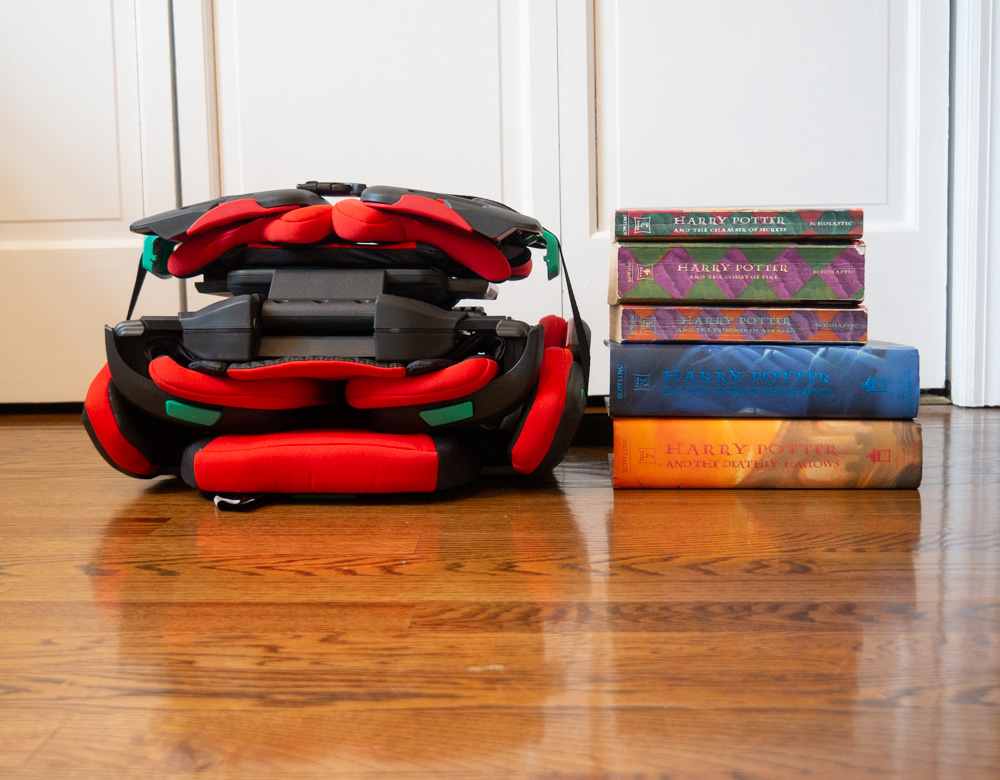
In a stroke of genius, the hi fold booster seat creators decided to make this a travel booster seat for true globetrotters: the same model is certified for use in the US, Canada and EU (under the UN regulations). That means you can legally use it in any country in the world except Australia – but they’re working on that one too.
Find out more about car seat rules around the world:
–Europe
–Australia
–Mexico
–Costa Rica
Who is the hifold fit-and-fold for?
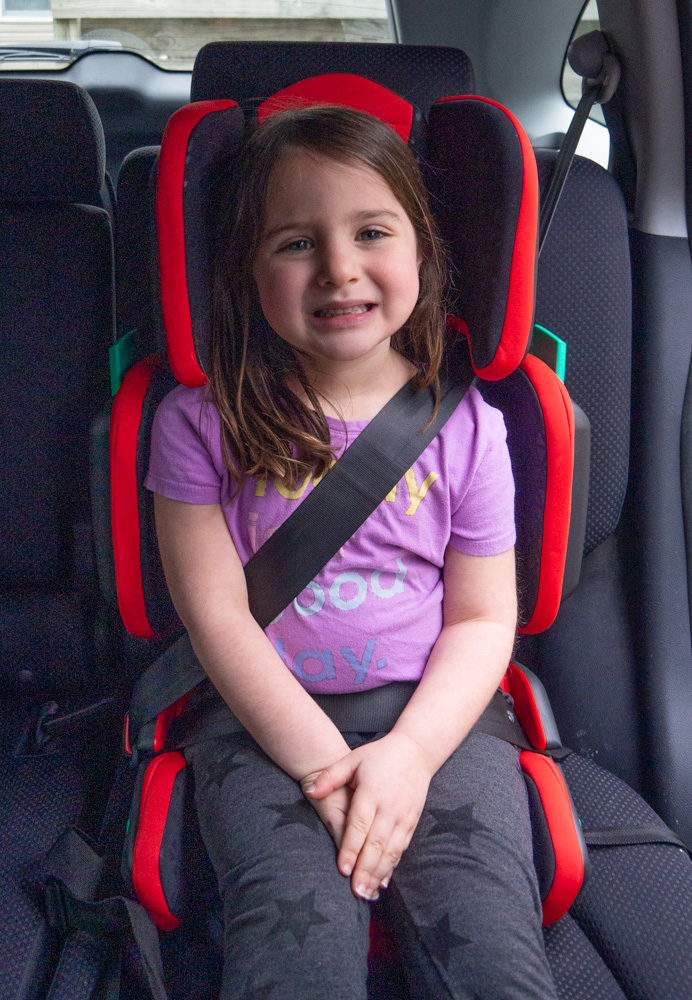
The stated minimum to use the hifold booster car seat is 4 years old, 40 pounds and 40” tall; all of those have to be true to be within manufacturer guidelines.
But let’s have a moment of honesty… most four year olds don’t belong in a booster seat. Not only are their bodies still developing the strength to withstand crash forces, but their minds are still developing the maturity to follow directions. If a four year old drops her toy or her water bottle, she’s almost certainly going to reach down to grab it. If he wants to bother his baby sister in the next seat over, a pesky seatbelt won’t stop him!
Need an ultra-portable solution for your 3 or 4 year old? Check out the WAYB Pico (in-depth review here).
So on the young end, who should be using the hifold? I’d put it at 5 years old. That’s when most kids are truly ready to ride in a booster seat. In an era when many child safety experts recommend keeping kids rear-facing until 4 years old, it’s reasonable to use a forward-facing harness for a year or two after that.
If you happen to have a very petite 5 year old, the hifold will fit your child really well! I’m impressed by how narrow it gets through the seat and torso and how low the back goes. It can be a struggle to fit small 5 (and even 6) year olds in some booster seats; for example, one of our seats at home has a minimum size of 44″ to use in high back booster seat mode – which our mature son didn’t hit until he was almost 8 years old!
What about at the top of the size range? The hifold is designed to fit kids up to 100 pounds and 59” tall! Wowza. I don’t have a kid that big to test it with, but it gets mighty tall as you’ll see below.
Read more: Choosing the best portable booster car seat
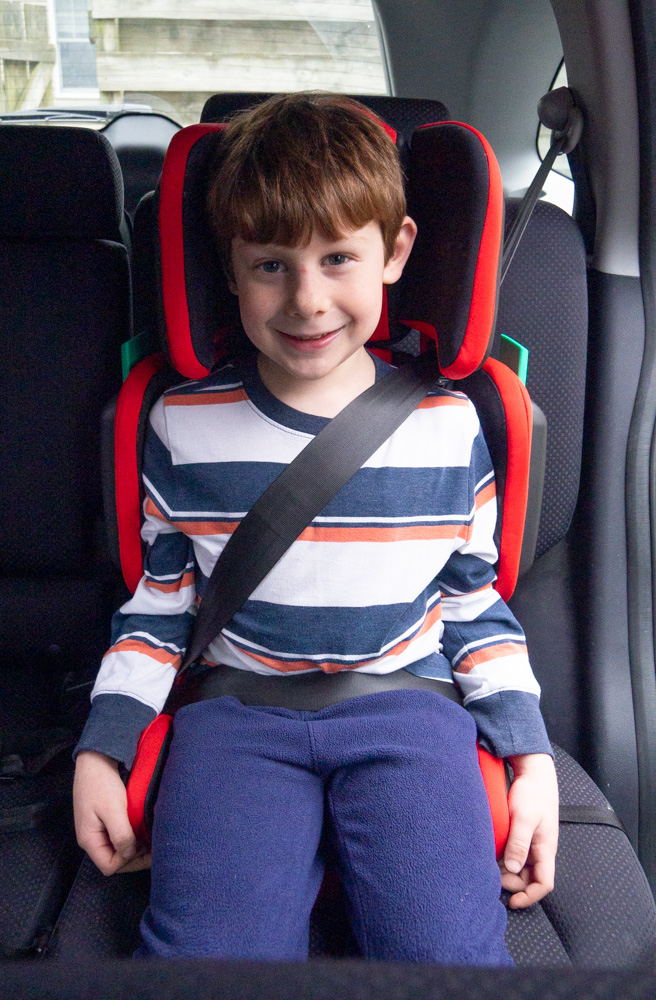
I suspect that true big kids – let’s say over 9+ years old – wouldn’t find it comfortable enough for more than a short ride. My son is 8.5 and small and the seat wasn’t deep enough to support him all the way through his thighs. Fortunately the boost isn’t very high so it was manageable, but I really can’t see a kid who’s 59” riding comfortably for long. So while the width may be ample for kids up to 100 pounds, I doubt the depth is.
Realistically, I’d say the useful timeframe for the hifold is 5 to 8 years old. That’s when most kids are riding in a high back booster seat at home too!
hifold booster seat install details
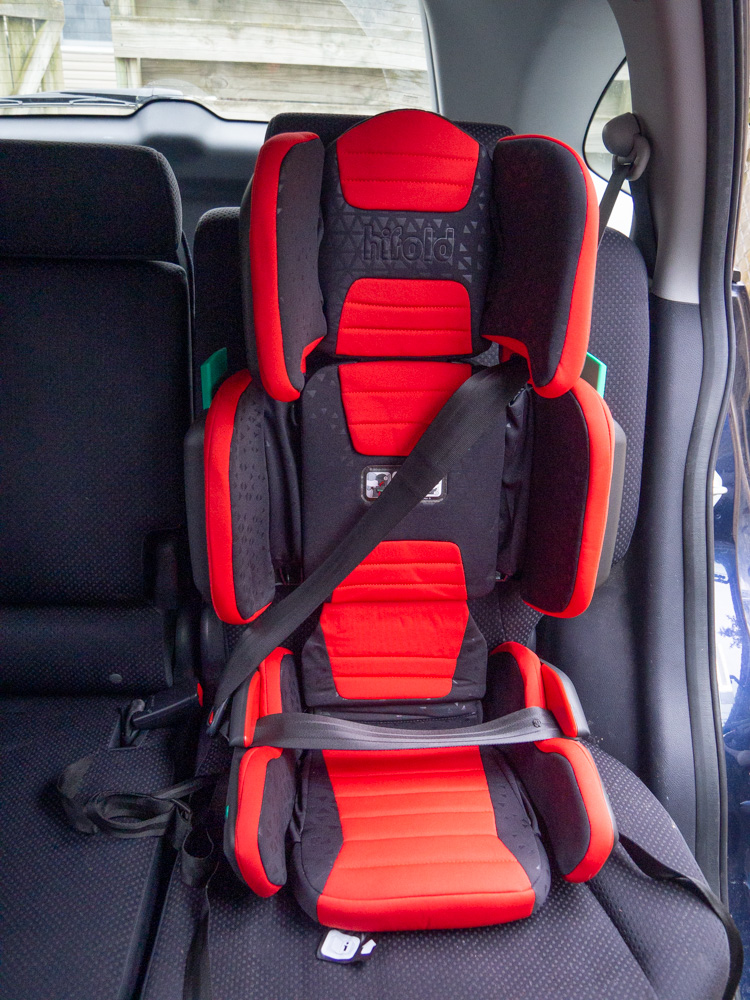
Before you can get to installing the hifold booster seat in your car, there is some preliminary set up. The manufacturer advertises 243 unique combinations thanks to the wide variety of adjustments, so it’s helpful to do a preliminary try with your kid before you’re in a high-pressure travel situation.
At the very least, you’ll want to know the correct width settings for your kid, which is easy enough. My petite 5.5 year old needed the narrowest widths for everything and my small 8.5 year old was on the medium widths for the seat and torso, but narrowest for the headrest.
Once you have the widths set, place the hifold on the car seat and thread the shoulder belt through the built-in belt guide. That’s the only real step to hifold installation!
You’ll need to set the seat height once you place it in the car. The manual says to start with it at its highest setting, but that’s probably overkill. Just start with it higher than you think you need it, have your child hop in and then start tweaking. Your kid will need to bend his head forward to grant you access to the lever, so it might take a few tries to get the height right.
There are a few important things to note before using the hifold in the car. First, only the lap portion of the seatbelt goes under the belt guides. We have some booster seats that require the shoulder belt to go under as well, but this isn’t one of them. Second, the hifold requires a headrest behind it. If you’re using it on a really tall setting, raise the headrest accordingly. Be sure to check your car manual to be sure you’re allowed to leave the headrest installed.
For this hi fold car seat review, I installed in my 2007 Honda CR-V; it may be old, but it’s a pretty representative family car. I had no issues with hifold fit, and the seat is narrow enough to fit nicely even in cars with high side bolsters on the seats.
One more thing… if you’re driving around without the kid, try to remember to buckle the hifold into place since it doesn’t have LATCH. Otherwise it’ll become a projectile in an accident.
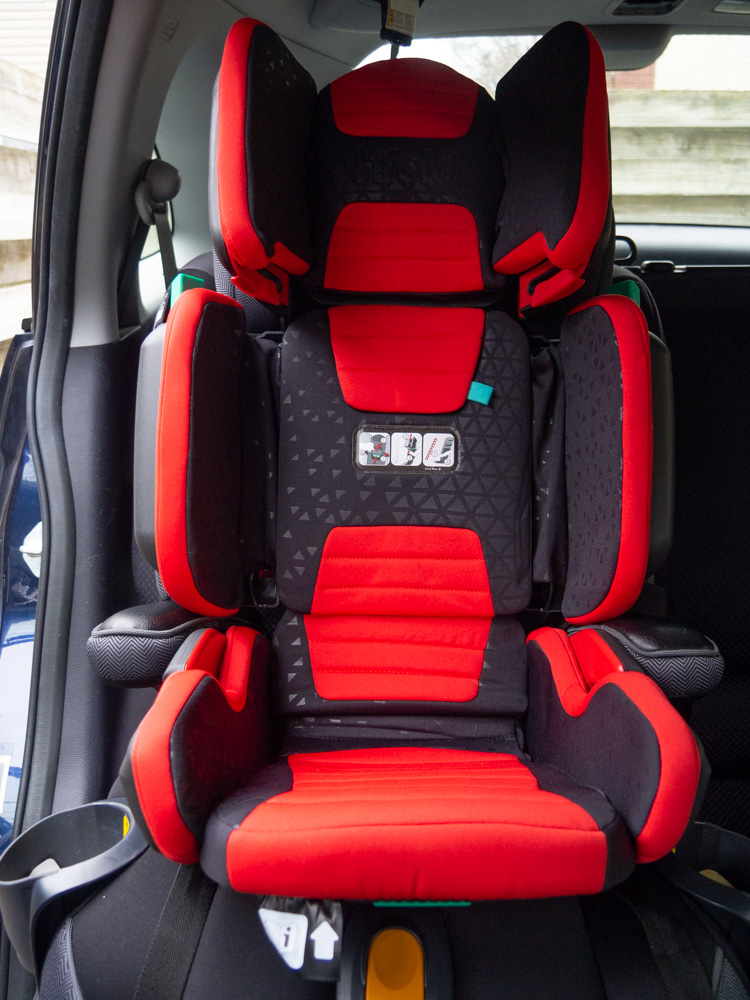
The hifold is impressively narrow no matter which setting you have it on. At its narrowest setting, the torso section is around 16.5″ wide; at its widest it’s around 18.5″. For comparison, the pretty average sized Chicco KidFit is about 20″ wide and the narrow Clek Oobr is almost 18″. Especially if you’re transporting kids who don’t need the full width of the hifold, it’ll be a snap to fit three across in many cars since this is such a compact booster seat.
How do you fold the hifold?
Folding the hifold is a combination of oragami, magic and practice. Reading the manual helps too! But I wanted to challenge myself to see if I could do it just using the stickers on the seat, since most parents don’t read manuals (#honesty).
It took me a few minutes to figure it out on my own, but I did get it basically right in the end. Do yourself a favor and check out the manual for guidance. The long and short is the make all the parts as narrow as possible, then start folding the side parts in, then start folding vertically.
When you’re done you’ll have a nice compact package that’s ready to go, whether under your child’s seat on an airplane or in the trunk of your car for the inevitable last-minute carpool.
Check out the official hifold video to see it in action:
Flying with hifold folding booster seat
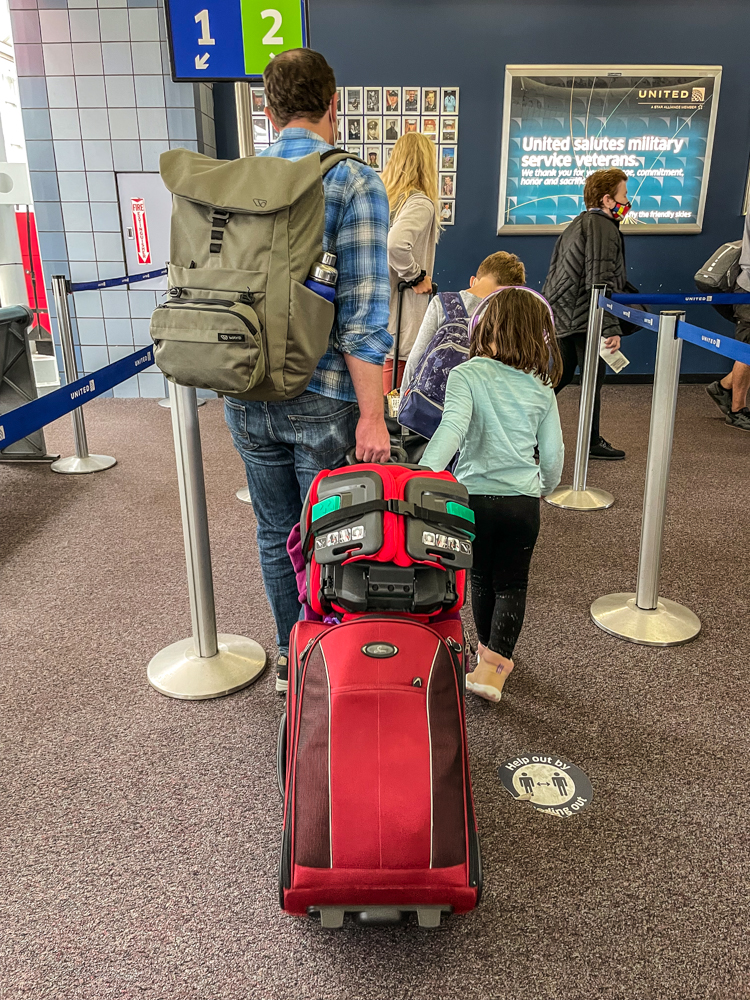
We finally had an opportunity to test out flying with hifold on our recent family trip to Alaska. The quick summary: it was perfect. Apart from occasionally sliding off to the side (remedied by wrapping the shoulder strap around the suitcase handle), hifold sat nicely on top of our carry-on suitcase as we walked miles and miles through airports.
Once on board our flights, the hifold easily fit in luggage storage areas. If the plane had been full, I could have turned it sideways to take up less space or put it in front of our daughter’s seat. Thankfully the folded size is extremely compact, so even on a tiny regional flight it stows away.
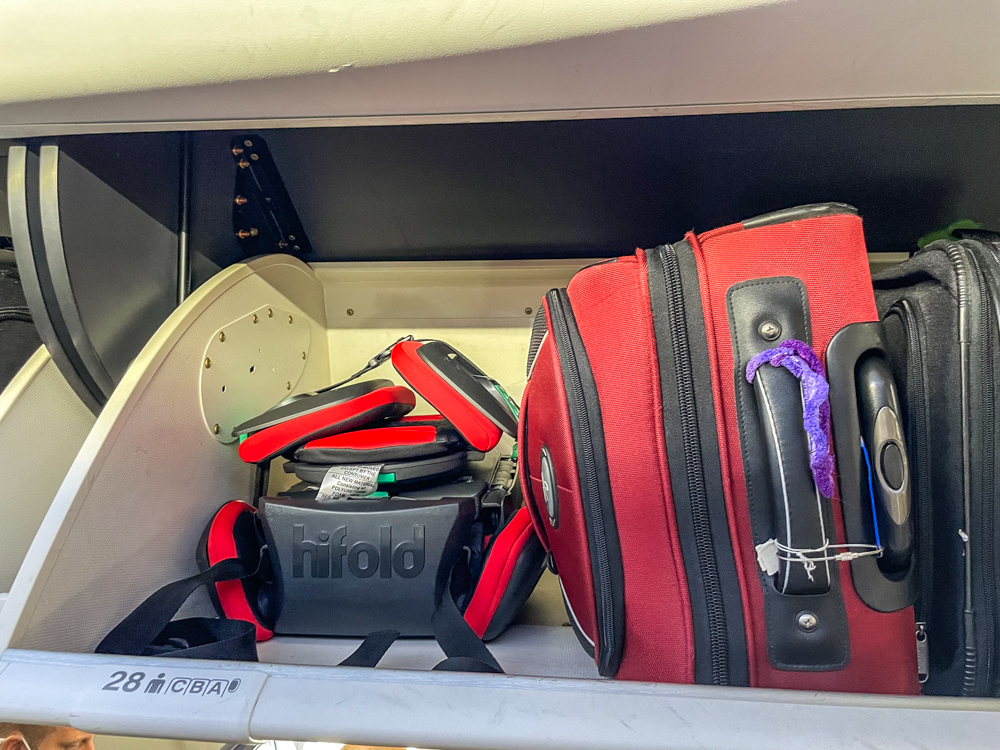
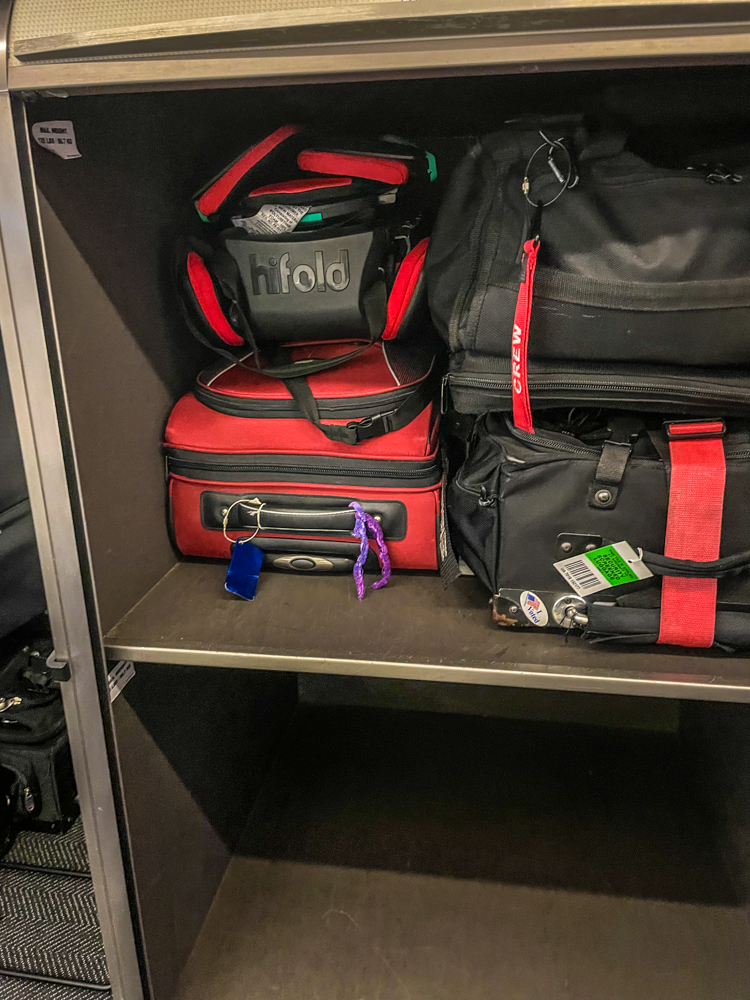
Obviously hifold isn’t nearly as compact as a backless booster seat, even one that doesn’t fold. However, on our first full day in Alaska I felt vindicated in my decision to bring hifold for our trip rather than one of our many other travel booster seat options: our 7 year old was able to buckle her self as we hopped in and out of the car all day, but when she fell asleep on an unexpectedly late drive she stayed in position safely.
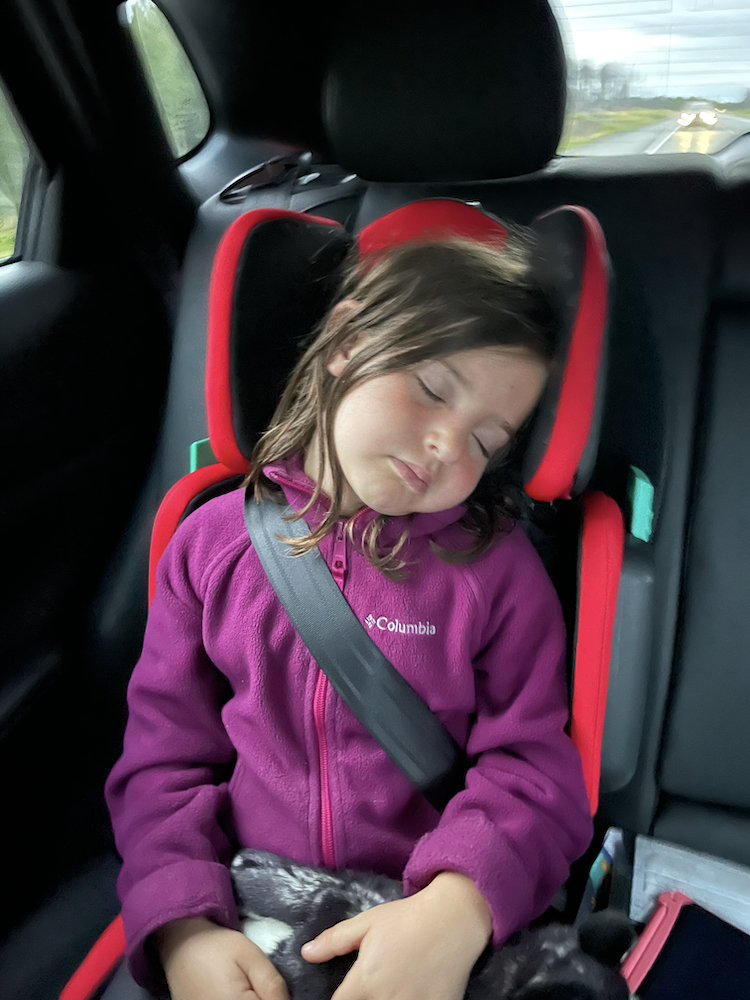
And there’s the rub. Even kids who are normally perfect booster riders may wind up exhausted on vacation due to busy days and time changes (in our case, both). While our daughter was safely positioned in her booster seat, our 9 year old son was drowsy too and I had to continuously push him back in position (from the front seat, which is obviously not safe) in his backless booster. Honestly I wish that I had a hifold for both kids!
How does the hifold car seat compare to other travel booster seats?
Read more: Bringing your booster seat on an airplane
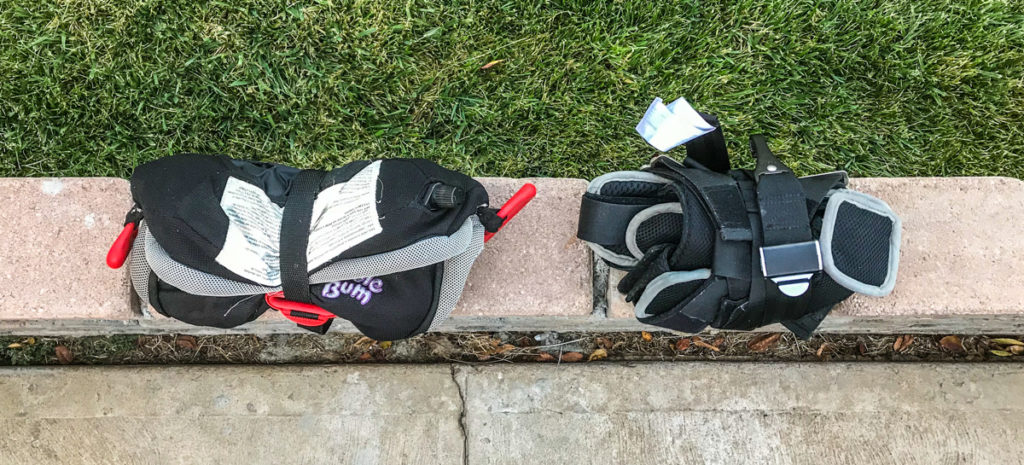
If you’re in the market for a highback booster, the hifold is definitely the most travel-worthy option! Others like the Graco Turbobooster Take Along Highback booster (which needs a shorter name) and the Baby Trend Yumi are too long when folded to work as carry-ons. And they’re way too big to consider taking with you for a day in the city that might involve hopping in an Uber. You can throw the hifold in a backpack or its well-designed travel bag and be on your way.
hifold vs Ride Safer travel vest
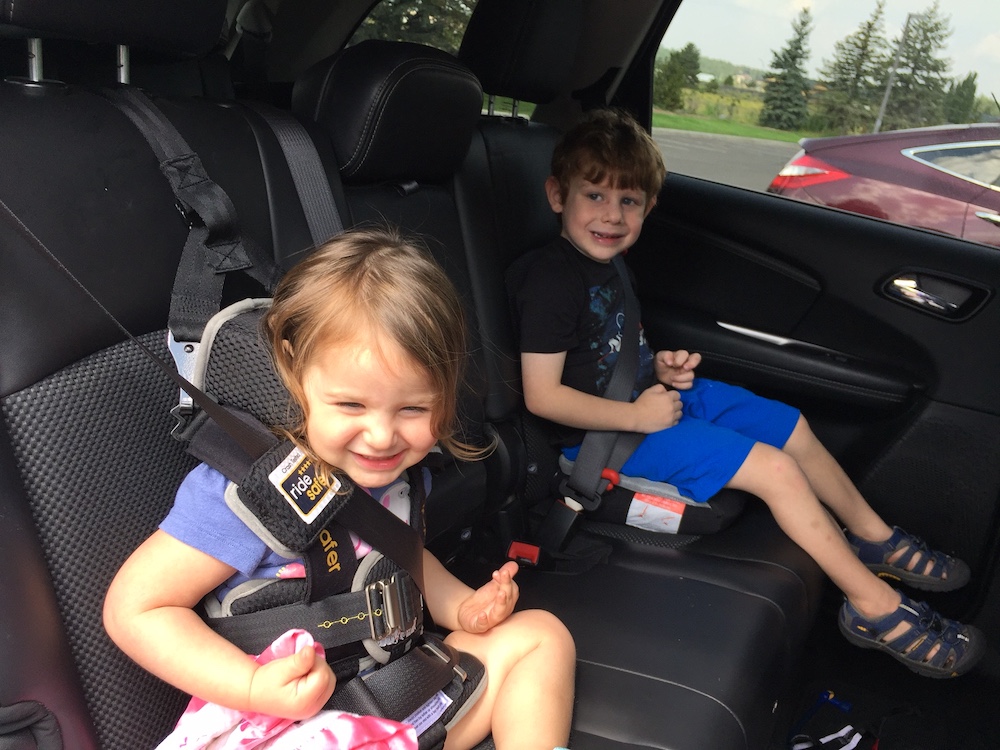
If you’re shopping for a 3-5 year old, you’re probably also considering the Ride Safer Travel Vest (full review here). The Ride Safer has the advantage that the top tether keeps even wiggly/sleepy kids from bending or slouching out of place. The vest is also a fraction of the size.
On the other hand, the vest can be tiresome to buckle over and over. If you’re doing a road trip that involves lots of stops, like a national park, you won’t want to bother getting your little one out of the vest every other minute. With the hifold, it’s no big deal.
I happened to be writing this review while on a cross-country flight. The minute we landed I had a terrible “oh shit” moment when I realized that we left the top tether for our Ride Safer back home. Since our daughter is still a car sleeper, I don’t feel confident using the vest without its top tether but unfortunately that’s just one more part to remember. One time my better half left it in a rental car and had to run back to get it! So the fact that the hifold doesn’t have any detachable-but-critical pieces is a huge saving grace.
The hifold also gives a little boost – not much, but every little bit helps when you have a small kid who’s eager to see out the window.
If you’re traveling overseas, the current Ride Safer travel vest may not be legal under the latest regulations even though older versions were. That’s a real shame, and I’ll be honest that we’ve always brought our own car seats to Europe including the vest. But if you want to feel confident that you won’t run into any legal issues, the hifold is a good choice.
Read more: In-depth Ride Safer travel vest review
hifold vs Bubblebum
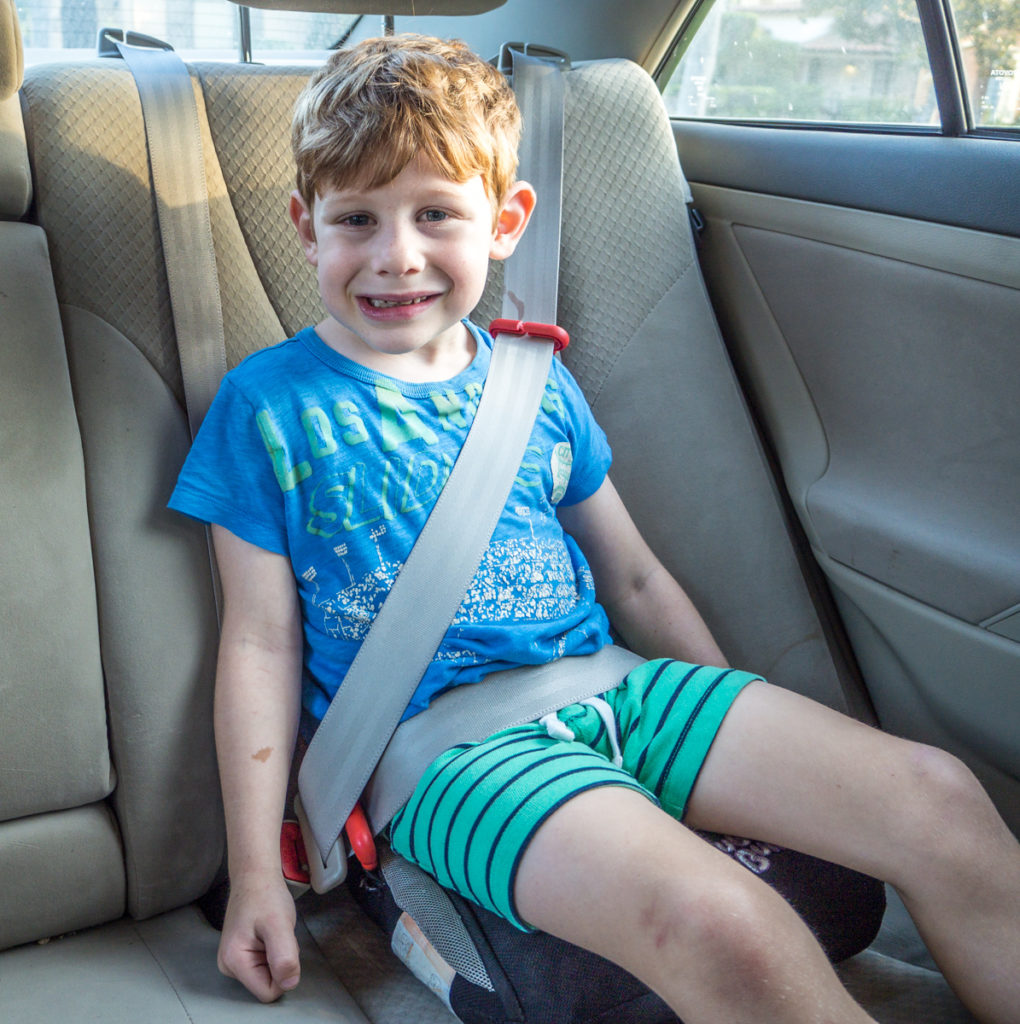
We love our Bubblebum (full review here) and travel with it all the time for our older child. But we didn’t start using it until he was 6 years old, very mature and rarely slept in the car.
The Bubblebum clearly wins on portability – it only weighs about a pound and rolls up to the size of a side bottle. It also provides a great fit in every car we’ve tried, which is a lot.
But the Bubblebum has absolutely zero support for car sleepers. There were a few times during our gap year when our son fell asleep and slumped forward; I would reach back from the front seat and shove him back into place. Not exactly glamorous, or safe. If he’d been riding in the hifold he would have most likely just leaned on one of the headwings to sleep.
Read more: In-depth Bubblebum review
hifold vs mifold

How does the hi fold car seat compare to its older-but-smaller sibling, the mifold grab and go booster seat?
Well, there’s obviously a huge difference in size. They just don’t even compare. The mifold is the smallest booster seat on the market.
But when it comes to fit and safety, I feel much more comfortable with my kids in the hifold than I would in the mifold. One big issue many car seat safety advocates and CPSTs have with mifold is that the lap belt guides sit really far forward, sometimes mid-thigh rather than at the top of the thighs – see my 7 year old daughter below. Some owners have also reported that the width-adjustable belt guides can sometimes adjust themselves unexpectedly.
Read more: Hands-on with the mifold comfort
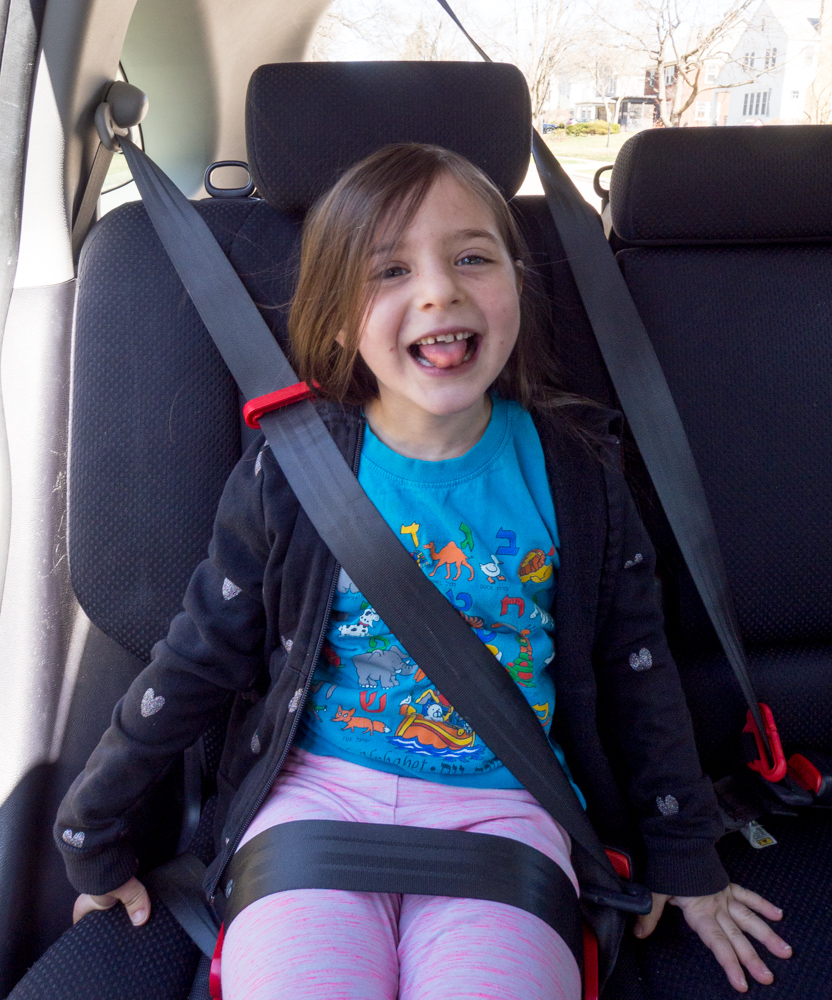
There are two important differences: first, the hifold belt guides are positioned such that both of my kids had the lap belt in the right place. Not too far forward, not too far back. Second, the belt guides adjust with the rest of the seat base – and even when you want to adjust that width, it’s not a smooth movement that can happen on its own. There’s a lever you have to pull with one hand while you adjust the width with the other.
On the comfort side, many kids complain that the mifold lacks padding for long rides. The hifold seat has a little more padding to it fortunately. It’s still nothing like what our kids are used to in their usual booster seat and combination seat, but an improvement over mifold nonetheless.
Hifold review: my impressions
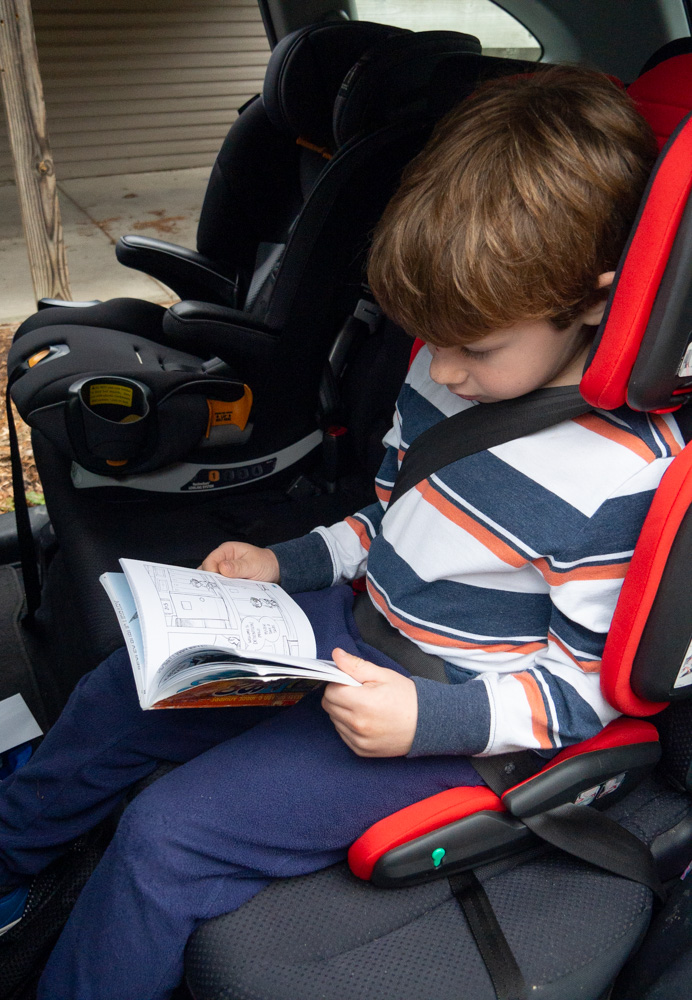
Overall, my kids and I like the hifold fit & fold booster seat. As you can see in the photos here, we had no issue getting a safe seatbelt fit on both of them thanks to all of the adjustments.
Advantages of the hifold fit and fold booster
- Excellent choice for kids 5+ who are mature (including petite riders)
- If you’re traveling out of the US, it’s legal almost everywhere!
- Offers better sleeping support than Bubblebum or mifold
- Easier in-and-out than Ride Safer travel vest
- Compact enough to take as a carry-on on a plane
- Fits a huge range of kids
- No extra parts to remember
- Doesn’t require a top tether, so it can be used anywhere there’s a lap-shoulder belt
- Shoulder belt guide is more secure than some other booster seats we’ve used
- Easy for kids to buckle on their own
Disadvantages of the hifold by mifold
- It’s much bigger and heavier than the Ride Safer travel vest or the Bubblebum, so families are less likely to have it for unexpected Uber rides
- Folding it can take some practice
- Needs to be re-adjusted every time you unfold it
- Shallow seating area may not be comfortable for bigger kids or longer rides
- The price tag can feel hard for families to justify for such a specialized product (though it’s easier to swallow if you can pass it down to a younger sibling in a few years)
- “Where’s the cup holder?” says my 8 year old; you can buy one for an extra $10, but I think it should be included at this price point
Suggestions for hifold version 2
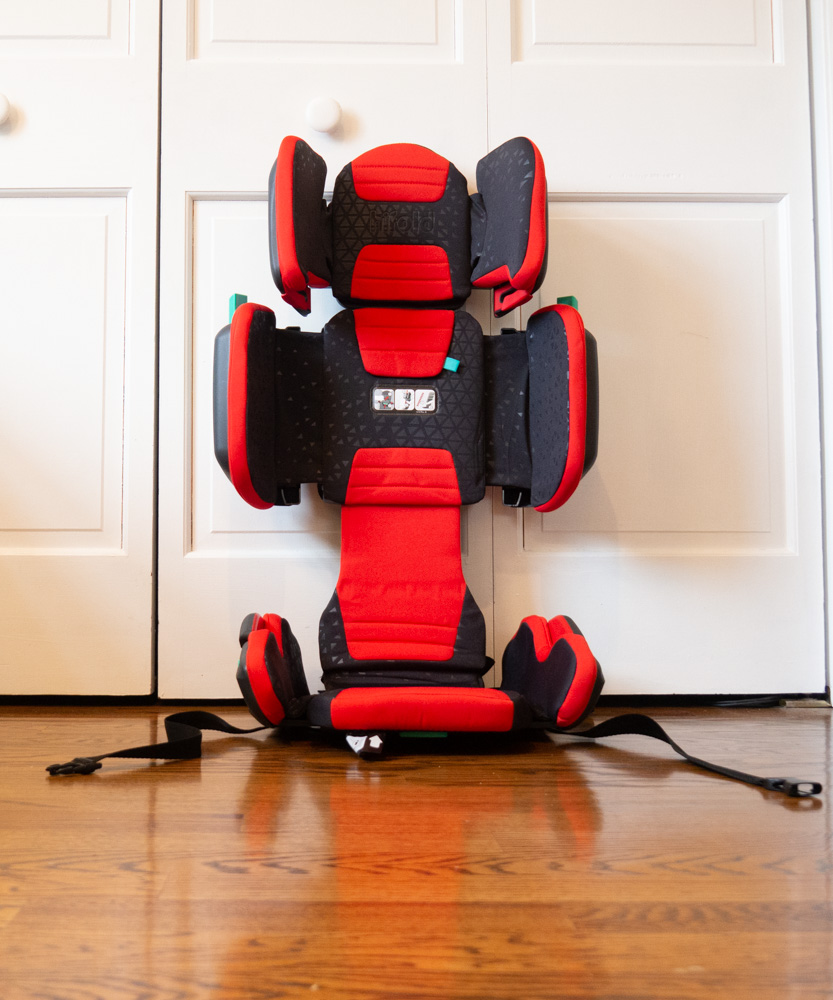
My biggest knock in this mifold hifold review is that it’s heavier and bulkier than other folding car seats that target the same age group. There’s one easy way to address that issue: make it fit fewer kids.
Crazy, right? Shouldn’t you want to fit as wide a range of riders as possible?
In reality, there shouldn’t be tiny 4 year old riding in a booster seat. Right there on the website it says “We recommend that children stay in a 5 point harness for as long as possible”.
On the upper end of the range, most 10-12 year olds wouldn’t find the shallow seat especially comfortable and they’re usually mature enough to move into a much smaller backless booster (especially for travel). In the photo above you can see that the hifold gets really tall – so tall that I had to lean it against the wall to keep it from falling over. I measured the top belt guide at 20″ – that’s taller than many traditional boosters.
While I haven’t done a deep dive into the hifold schematics, I suspect that narrowing the focus to 5-8 year old sizes could allow the designers to drop some weight (and maybe even a little size when folded). That would make the hifold more practical for travel and also give parents a more realistic impression of the useful lifespan.
Conclusion: Is the hifold worth buying?
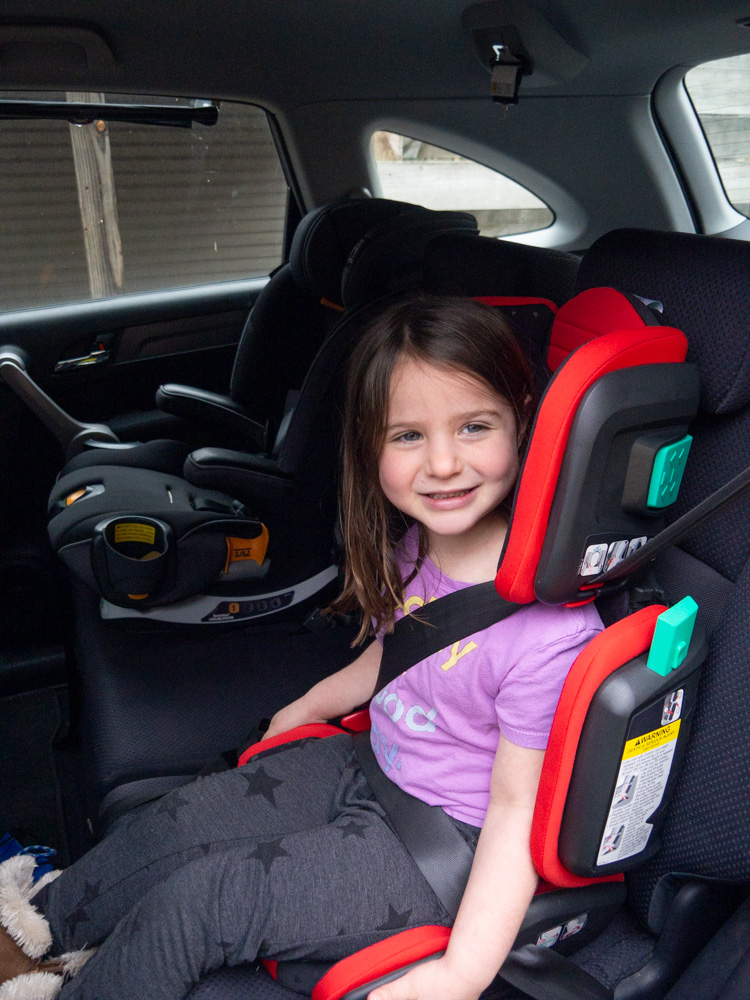
As with all of the innovative, travel-specific gadgets on the market today, the hifold is meant for a specific niche. It’s not going to be the right product for every family, and that’s ok.
If you have a kid who is 5-8 years old and you’ll be traveling, the hifold is an excellent choice. It’s safe, it’s legal almost everywhere, it’s comfortable and it’s relatively portable. There’s truly a lot to love here for globetrotting families!
I also highly recommend it for families with mature 5 or 6 year olds who are on the smaller end of the growth curve. It’ll fit your peanuts really well, even when they don’t meet the minimum requirements for other popular booster seats. Update: We’ve been using it around town for several months now and my son still likes it!
Where to get your hifold
Key stats:
-Weight 10lbs
-Highback booster size limit 4yo, 40-100lbs, 40-59″
-Belt guide 14-20″
Pros:
✔ Tons of size adjustments for great fit
✔ Folds down small
✔ Legal to use everywhere except Australia (in progress)
✔ Extremely narrow
✔ 7 year expiration
Cons:
✘ Expensive if you will only use for a few years
✘ No cup holders included
✘ Bigger than some of the other travel-specific car seats
Thanks to mifold for providing a hifold for review. All opinions are my own.
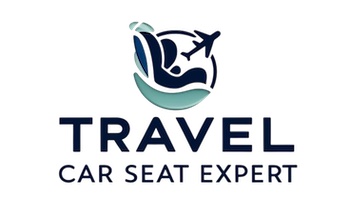

I have a tall and skinny 4.5 year old, and we need an easy travel solution. She is already 45″, so at the max Wayb height. And, you’re right! I am looking at the hifold as well as the Ride Safer vest. Based on the above review, I am inclined to choose the Ride Safer vest, however, one of its “cons” is no side impact protection. Does the hifold provide that side impact protection? And, if she isn’t a squirmy rider and listens well, is the hifold a better option? We would only be using this for one way trips from the airport when traveling – so not very worried about the time it takes fo buckle with the Ride Safer…. what do you think??
Hi Lara,
The US doesn’t have side impact testing standards yet, and the version of EU certification that the hifold has doesn’t require side impact testing either. That said, hifold does have impact-absorbing layers in the head and side wings.
Usually we like kids to be at least 5 to ride in a booster, as that’s generally how long it takes to them to reach the maturity to sit properly all the time. Some kids are ready for that responsibility at 4.5. If she’s over 40lbs and you’re confident she’ll sit properly 100% of the time, the hifold could be an appropriate choice.
As you probably realize, we own both (along with dozens of other travel-worthy car seats!). The “right one” depends on the circumstances for us. If we’re renting a car and driving around on our own for a week, I prefer a traditional booster for easy in and out. If we’ll be doing a mix of car/Uber/public transportation I prefer the vest for portability. The vest also gives you the option to use the top tether and potentially even lock the seatbelt if you think your daughter will be sleepy (though my daughter has no issue sleeping in hifold).
I’m sorry there isn’t a more clear-cut answer but hopefully this helps!
Safe travels,
Melissa
Thanks for the detailed review including the hifold vs vest comparison. My youngest is almost 5 but only sometimes weighs 40 pounds or more. Typically he weights in around 39.5. I’m leaning toward the ride safer vest (we had an evenflo for travel before but he maxed out the height), but would welcome any thoughts.
Hi Meg,
Thanks for stopping by. I’d probably stick to the Ride Safer Travel Vest and use that while he’s 5 and 6, then switch to the Bubblebum down the line if he’s ready for it. That said, if he’s truly close to 5 and mature enough to sit properly 100% of the time the hifold could be a very nice option with lots of longevity.
Safe travels,
Melissa
Hello,
I I saw that you listed the hifold as being suitable for kids as small as 33 lbs, if they can sit properly. I wasn’t able to find any other online sources that say a child can be less than 40lbs to use the hifold. Im hoping it’s okay to use for my 5 year old who weighs 37-38 lbs. I’m wondering, was that the weight requirement for European standards and in the U.S. they have to say only 40 lbs and up?
Thank you!
Hi Lisa,
Thank you so much for your comment! mifold recently updated the minimum requirements, in line with all other US manufacturers, which I’m very pleased to see. That said, it’s still physically the same seat and in Europe it’s still sold with a 15kg (33lb) minimum.
Another option you can consider is the Ride Safer Travel Vest. It has a different set of pros and cons that you can read about in my review, though if you’re traveling to Europe one con is that the current version isn’t legal there. My kids are also quite small and they used the vest for travel at ages 5 and 6.
Safe travels,
Melissa
What do you recommend for Europe for a 3 year old and 8 year old for travel
Hi Chloe,
Thanks for stopping by! It depends on your needs, particularly public transit vs renting a car. Here are some unique considerations for bringing a car seat to Europe.
The 8 year old is fairly easy, assuming kiddo is mature enough to sit properly at all times. You can grab one of these portable booster seats.
For your 3yo, one of these travel car seats should work well. Be sure to pay attention to heights and weights.
Safe travels,
Melissa
Hola
Donde puedo conseguir una silla de estas?
Gracias.
Hola,
Lo siento pero creo que hay problemas de producción. Hifold no es disponible en este momento 🙁
Buen viaje,
Melissa